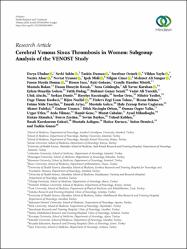Cerebral venous sinus thrombosis in women: subgroup analysis of the VENOST study

Göster/
Erişim
info:eu-repo/semantics/openAccessTarih
2020Yazar
Uludüz, DeryaŞahin, Şevki
Duman, Taşkın
Öztürk, Şerefnur
Yayla, Vildan
Afşar, Nazire
Uzuner, Nevzat
Midi, İpek
Çınar, Nilgün
Sungur, Mehmet Ali
Domaç, Füsun Mayda
İnce, Birsen
Göksan, Baki
Mısırlı, Cemile Handan
Bakar, Mustafa
Kozak, Hasan Hüseyin
Çolakoğlu, Sena
Karahan, Ali Yavuz
Göksu, Eylem Özaydın
Özdağ, Fatih
Şenol, Mehmet Güney
Yürekli, Vedat Ali
Aluclu, Ufuk
Demir, Serkan
Küçükoğlu, Hayriye
Oruç, Serdar
Yeşilot, Nilüfer
Küsbeci, Özge Yılmaz
Nazlıel, Bijen
Tokuç, Firdevs Ezgi Uçan
Bektaş, Hesna
Taşçılar, Fatma Nida
Aytaç, Emrah
Gökçe, Mustafa
Çağlayan, Hale Zeynep Batur
Tüfekçi, Ahmet
Uzuner, Gülnur
Örken, Dilek Necioğlu
Yalın, Osman Özgür
Utku, Uygar
Yılmaz, Arda
Genç, Hamit
Çabalar, Murat
Milanlıoğlu, Aysel
Ekmekçi, Hakan
Zeydan, Burcu
Baybas, Sevim
Kablan, Yüksel
Göksel, Başak Karakurum
Açıkgöz, Mustafa
Kurucu, Hatice
Demirci, Seden
Güneş, Taşkın
Üst veri
Tüm öğe kaydını gösterKünye
Uluduz, D., Sahin, S., Duman, T., Ozturk, S., Yayla, V., Afsar, N., Uzuner, N., Midi, I., Cinar, N., Sungur, M. A., Domac, F. M., Ince, B., Goksan, B., Misirli, C. H., Bakar, M., Kozak, H. H., Colakoglu, S., Karahan, A. Y., Goksu, E. O., Ozdag, F., … Gunes, T. (2020). Cerebral Venous Sinus Thrombosis in Women: Subgroup Analysis of the VENOST Study. Stroke research and treatment, 2020, 8610903. https://doi.org/10.1155/2020/8610903Özet
Background. Early diagnosis of cerebral venous sinus thrombosis (CVST) associated with reproductive health-related risk factors (RHRF) including pregnancy, puerperium, and oral contraceptive (OC) use can prevent severe neurological sequelae; thus, the symptoms must be documented in detail for each group.Methods. Out of 1144 patients with CVST, a total of 777 women were enrolled from a multicenter for the study of cerebral venous sinus thrombosis (VENOST). Demographic, biochemical, clinical, and radiological aspects were compared for 324 cases with RHRF and 453 cases without RHRF.Results. the mean age of the RHRF (-) group (43.2 +/- 13 years) was significantly higher than of the RHRF (+) group (34 +/- 9years). A previous history of deep venous thrombosis (3%), isolated cavernous sinus involvement (1%), cranial neuropathy (13%), comorbid malignancy (7%), and its disability scores after 12 months (9%) were significantly higher in the RHRF (-) group. the RHRF (+) group consisted of 44% cases of puerperium, 33% cases of OC users and 23% of pregnant women. the mean age was found to be higher in OC users (38 +/- 9years). A previous history of deep venous thrombosis was slightly higher in the pregnancy subgroup (4%). Epileptic seizures were more common in the puerperium group (44%).Conclusion. the results of our study indicate that the risk of CSVT increases parallel to age, OC use, and puerperium period. in addition, when considering the frequency of findings and symptoms, epileptic seizures in the puerperium subgroup of the RHRF (+) group and malignancies in the RHRF (-) group may accompany the CSVT. in daily practice, predicting these risks for the CSVT and early recognition of the symptoms will provide significant benefits to patients.

















